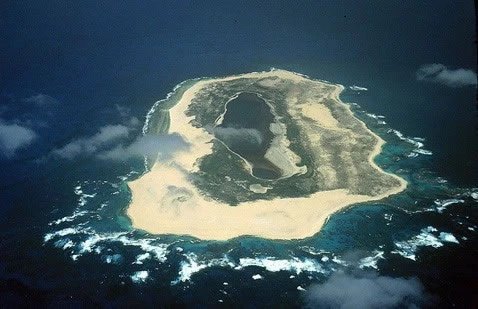Laysan Island

The Hawaiian name of Laysan Island is Kauō, meaning egg, which refers to the island's shape and how much life springs from the island. It is located 930 miles (1,496 km) northwest of Honolulu. Its land area encompasses 1,588 square miles (4,114 km²). At about 1 mile in width and 1.5 miles in length, it is the second largest land mass in the Northwestern Hawaiian Islands. Laysan Island has fringing reefs and a shallow and very salty 100-acre lake in its interior, about eight feet (2.4 m) above sea level. Its salinity content is about three times more than the ocean. It is the only lake in the Northwestern Hawaiian Island chain and one of only five natural lakes in the entire state of Hawaii. Laysan's tallest point is about 40 feet (12 m) above sea level, located on a large dune on the northern point of the island.
Laysan's history has been troubled because in the late 1800s and early 1900s, guano and feather harvesters killed thousands of birds, which caused dramatic changes in the island's ecosystem. Also, rabbits were introduced to the island, but soon the multiplied and the vegetation on Laysan wasn't enough to feed them. According to Professor William Alanson Byron of the Bishop Museum, there were about 10 million seabirds on Laysan in 1903, but just eight years later there were just a little more than a million. In these eight years, also the Pritchardia palms that were endemic to Laysan and the island's sandalwood trees became extinct.
Another of the island's inhabitants, a German immigrant named Max Schlemmer, who arrived in 1894, brought European Hares and guinea pigs to Laysan to prepare for a future meat canning business. All these events led to the rapid decline of the ecosystem on Laysan. These events caused a public outcry, which led President Theodore Roosevelt to declare the Northwestern Hawaiian Island chain a bird sanctuary in 1909.
Schlemmer continued to allow the Japanese to export illegal bird wings and because of that was later removed from Laysan. Because the many rabbits had eaten so much of the island's vegetation, much of the soil became loose and blew around in dust storms. By 1918, the island could sustain no more than 100 rabbits and 26 plant species had been eliminated. Also, the Laysan Millerbird had become extinct.
The Tanager Expedition, which arrived in 1923, exterminated the remaining rabbits. By then, the bird population had been reduced to about one tenth of its former size and many plant species had been erased. The Laysan Duck and the Laysan Finch, two other endemic species, survive to this day but are endangered.
Although Laysan Island experienced so much abuse and an extinction period in its past, it has the most biodiversity and is considered the "gem" of the Northwestern Hawaiian Islands. Besides being home to the Laysan duck and the Laysan finch, 18 other bird species nest here. Native plants which had been eradicated during the extinction period, such as the eragrostis variabilis, were later reintroduced from other neighboring islands by scientists. Other seabirds on Laysan include the black-footed and Laysan albatross, Christmas and wedge-tailed shearwaters and bristle-thighed curlews. Like most other Northwestern Hawaiian Islands, many Hawaiian monk seals and green sea turtles live here.
Laysan Island has beautiful white-sand beaches and dry coastal grasses. Much of Laysan's shoreline is composed of old coral reef and coral sand, which as time went by has become cemented together to form rock. Although the reef at Laysan is the smallest of all the Northwestern Hawaiian Islands (145,334 acres / 588,146 km²), the island's rocky intertidal area is home to numerous invertebrate species, algae and fish. Furthermore, 28 species of stony coral can be found here, and branching corals are common. The island is protected by the Hawaiian Natural Life Act of 1961.
Like most of the other Northwestern Hawaiian Islands, Laysan is uninhabited. After years of restoration efforts by the U.S. Fish and Wildlife Service, pests, rats, rabbits and weeds have been eliminated and the some imperiled species and the native vegetation has been widely restored. Today, many consider Laysan one of the "crown jewels" of the Northwestern Hawaiian Islands. However, some perils continue to threaten this vulnerable island.
Even though Laysan is a remote place, all sorts of garbage that is thrown off of ships gets washed ashore. This poses a threat to the birds because they swallow the smaller pieces, which remain undigested in their stomachs. Also, a container with poisonous carbofuran had floated to shore and burst open in the 1990s, creating a "dead zone," which killed any living animal that went near it. This area is still off-limits.











